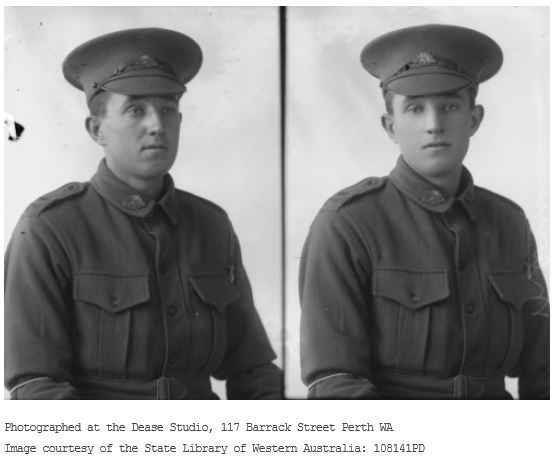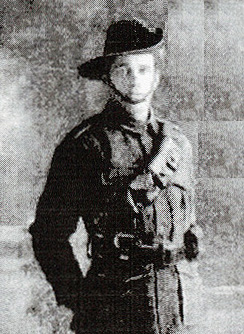William Clarence Martin DCM & Bar
From Our Contribution
 | |
 | |
| Personal Information | |
|---|---|
| Date of Birth | 28 Dec 1890 |
| Place of Birth | Jarrahdale, Western Australia |
| Death | 29 Jan 1970, aged 79 |
| Place of Death | Floreat Park, Western Australia |
| Age at Enlistment | 24 years, 7 months |
| Description | 5' 6½" (1.69m) tall; weight 156 lbs (70.8 kg); fair complexion, grey eyes and fair hair. Scar over right eye. |
| Occupation | sleeper cutter |
| Religion | Church of England |
| Address | Kelmscott, Western Australia |
| Next of Kin | Father Mr George Kerslie Martin |
| Military Information | |
| Reg Number | 1340 |
| Date of Enlistment | 22 Jul 1915 |
| Rank | Sergeant |
| Unit/Formation | 10th Light Horse Regiment, 10th Reinforcement / 3rd Light Horse Brigade, NZ and Australian Division |
| Date of Embarkation | 13 Oct 1915 - unknown at Port Suez |
| Ship Embarked On | HMAT A32 Themistocles |
| Date of Return | 29 Apr 1919 - 29 May 1919 |
| Ship Returned On | SS Dorset from Port Said |
| Fate | Returned to Australia |
| Monument | Kelmscott |
| Medals |
Distinguished Service Order 1914-15 Star British War Medal Victory Medal |
Pre War
“William Clarence Martin (1890-1970), horseman, soldier and pastoralist, was born on 28 December 1890 at Jarrahdale, Western Australia, son of George Kersley Martin, labourer, and his wife Rose Sarah, née Markwell. He attended Kelmscott Primary School until he was 14, then went as a jackaroo to a station in the Murchison district." [1]
War Service
Martin enlisted in the Australian Imperial Force on 13 July 1915 and in October embarked at Fremantle with the 10th reinforcements for the 10th Light Horse. Too late for Gallipoli, they landed in Egypt in November and joined their unit the next month.
Early in 1916 the regiment took part in the Egyptian Expeditionary Force's advance across Sinai into Palestine. Martin joined the 3rd Light Horse Brigade scouts during 1916 and as early as September 1917 was recommended for an award.
In November he was promoted Lance Sergeant. By April 1918 the British had reached the Jordan. During a difficult and ultimately unsuccessful raid 29 April on Es Salt across the Jordan, Martin led an advanced section of the brigade scouts. He and another scout crept up on a Turkish observation post, captured two of the enemy and killed the rest. Martin was awarded the Distinguished Conduct Medal.
After the failure to secure Es Salt the troops spent four months in the Jordan valley in oppressive heat. In September the British planned to take Damascus. On the night of 27-28 September, the 10th Light Horse, to which Martin had returned in June, forced the Jordan crossing above Jisr Benat Yakub in the face of heavy machine-gun and rifle fire. Martin was riding close to his troop commander when the latter was wounded. He took command and pushed on with the charge. The ground was impossible for horses, so the men dismounted in the semidarkness and, with Martin in the lead, rushed at the enemy with bayonets and engaged in hand-to-hand fighting. Over fifty prisoners and two machine-guns were captured. Martin was awarded a Bar to his D.C.M. and promoted sergeant on 6 November.
In the opinion of his commanding officer, Martin was not only 'exceptionally brave', but possessed a 'rare intelligence and cool judgment which did not impair his brilliancy and dash'; his guide work was 'really wonderful'.
In April 1919 Martin was invalided to Western Australia with malaria and discharged from the A.I.F. on 25 October 1919.
Award Comment
Distinguished Conduct Medal
He was in charge of a section of the brigade scouts acting ahead of the brigade on its advance from Jisr ed Damie to Es Salt on 30 April, 1918. He and one member of his section advanced to within 25 yards of an enemy observation post, unobserved, and captured two of the enemy and killed the remaining enemy.[2]
Bar to Distinguished Conduct Medal
For gallantry and devotion to duty on the night of 27-28 September, 1918. When the regiment forced the crossing across the river Jordan in the face of heavy machine gun and rifle fire, this non-commissioned officer, after his troop leader was wounded, assumed command and gallantly pushed on against the enemy's position, which resulted in the capture of fifty prisoners and two machine guns.' [3]
Post War
Electoral Roll entries : 1916 - 1925 sleeper cutter at Inglehope near Holyoake; 1925 - 1968 pastoralist at Mt Padbury Station.
Following his discharge, Bill went droving in the Kimberley.
Later, using money earned from droving and his entitlement under the repatriation land settlement scheme, he bought the major share in Mount Padbury Pastoral Co. near Meekatharra. He lived there until selling out about 1969.
He had married Nellie Cooree Francisco at St Mary's Anglican Church, West Perth, on 25 January 1923. They had a son but the marriage ended in divorce.
Bill Martin was a rugged character, about 5 ft 9 ins (175 cm) tall, and a good horseman and buckjumper who loved mustering and camping out. He died of leukaemia in Sir Charles Gairdner Hospital, Perth, on 29 January 1970, leaving an estate of $72,154, and was cremated with Anglican rites.
On the basis of his appearance and performance he was chosen to represent light horsemen in a series of paintings of the A.I.F. commissioned by the Australian War Museum Committee. Two portraits by Frank Crozier are in the Australian War Memorial.”[4]